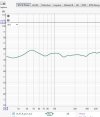Sure basically audyssey gets many things wrong, such as the cross over and the speaker type (small vs large). Audyssey has no way of confirming the actual parameters it sets, it is basically a shot in the dark.
But more importantly, it destroys my low end responce. During initial spl matching, because of a strong room mode at 48hz, it thinks this is the responce of sub and instructs me to lower the sub gain to 10%.
It then lowers the 48hz peak and determines the rolloff of my sub is at 40hz! The resulting responce is criminal.


